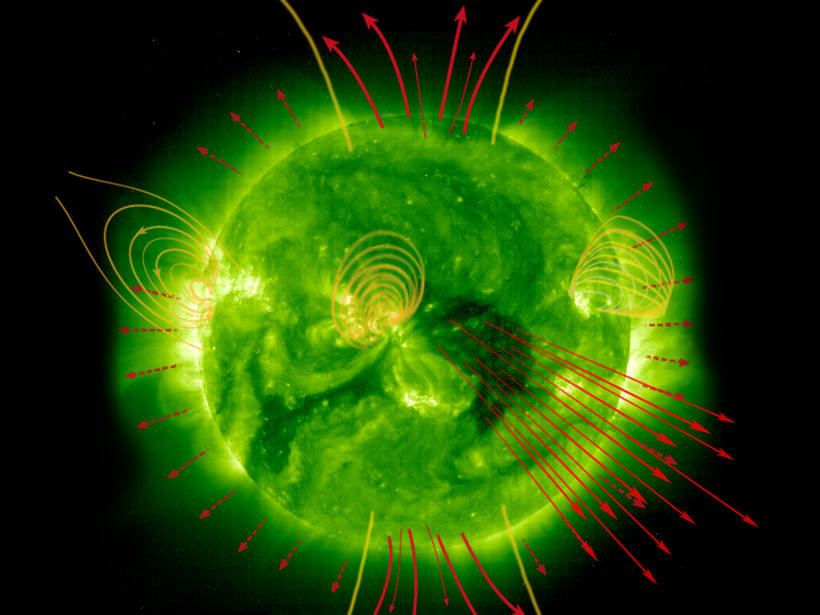Earth is relentlessly barraged by the solar wind, a soup of plasma that spews from the Sun at up to 1.7 million miles per hour. But some of that soup moves at a comparative crawl. AGU spoke with Journal of Geophysical Research: Space Physics editor Larry Kepko about his team’s new research into the composition and origin of this leisurely “slow” solar wind. Read their complete paper in Geophysical Research Letters.
What recent advances led to your team’s developments (or a new synthesis of previous developments)?
The abundances of “heavy” elements (beyond helium) in the solar wind are quite low, and because of this it takes time to accumulate enough counts to provide estimates for density. Previous studies examining solar wind composition have therefore looked at long (hours) timescales. The ACE SWICS team recently created a new data set of high time resolution (12 minute) measurements of the abundances of heavy elements and their number of electrons (or charge state) for certain intervals, which enabled this new study. While solar wind variability at 90 minutes – the time scale examined in this paper – were already known to occur, it was primarily thought of as random or turbulent. We focused on an interval of previously studied 90 minute oscillations. These periodic density structures are ubiquitous features of the solar wind. Using the periodic structures allowed us to use the boundaries of the structures as fixed bases for comparison. We could then look inside each structure to see if the composition varied in a systematic fashion. And we found that it did.
Why is it important that we understand the origin of the slow solar wind in particular?
The solar wind is generally divided into two types of wind: “fast” traveling more than 500 km/s and “slow” traveling fewer than 500 km/s. Although the fast solar wind comprises a larger portion of the Heliosphere (the pocket created by the solar wind), the slow wind dominates the ecliptic plane where all the planets reside. This is especially true during solar minimum, when sunspots are least abundant. Therefore, Earth spends the majority of its time in the slow wind — you could think of this as our base level “space weather” pattern. The source of the slow wind is thought to be near the boundary between the closed field corona and the open field (coronal hole) regions where the fast solar wind emanates. A lot of interesting physics occurs at the boundary, but we have no way of making in situ measurements in this region (at least until Solar Probe Plus launches). Our work demonstrates that clues are left in the slow solar wind about how it is created. Periodic density structures contain imprints of the processes that created them at the sun. So by examining data at a million miles upstream of Earth, we can obtain information about what occurred 3 days earlier at the sun when these features were created. In the process, we show that magnetic reconnection – a fundamental, universal process in which opposed magnetic field lines are broken and reconnected – creates these structures and forms the slow solar wind.
Can you extrapolate any implications for society, or for our understanding of Earth’s own processes?
The Earth lives in the slow solar wind much of the time. To accurately predict this dynamic wind requires an understanding of its creation. The sizable density fluctuations in the slow wind buffet Earth’s magnetosphere, filling it with a zoo of waves. Since the structures we examined were periodic, the compression and relaxation of the entire magnetosphere occurs in predictable intervals, causing globally coherent (consistent) waves in Earth’s magnetic field. These waves in turn can play an important role in particle energization and diffusion, particularly in radiation belts, or the layers of charged particles magnetically held in place around our planet.
What are the major unsolved or unresolved questions, and where are additional efforts needed?
This was just a single event study for which we had the high time resolution composition measurements. While we believe based on earlier studies that it is a representative event — i.e., there is nothing particularly unique about it – we still do not know exactly how often solar magnetic reconnection creates structures in the solar wind which survive to 1 Astronomical Unit, or the distance from Earth to the Sun. Another huge unknown is why the reconnection itself should be periodic. Is it driven from the lower solar corona, or is this an inherent property of the reconnection? For this we will be turning to numerical simulations, and of course anxiously await the launch of Solar Probe Plus.
—Larry E. Kepko, Editor, Journal of Geophysical Research: Space Physics; email: [email protected]
Citation:
Kepko, L. E. (2016), Chasing down the slow solar wind, Eos, 97, https://doi.org/10.1029/2018EO052505. Published on 20 June 2016.
Text © 2016. The authors. CC BY-NC-ND 3.0
Except where otherwise noted, images are subject to copyright. Any reuse without express permission from the copyright owner is prohibited.

